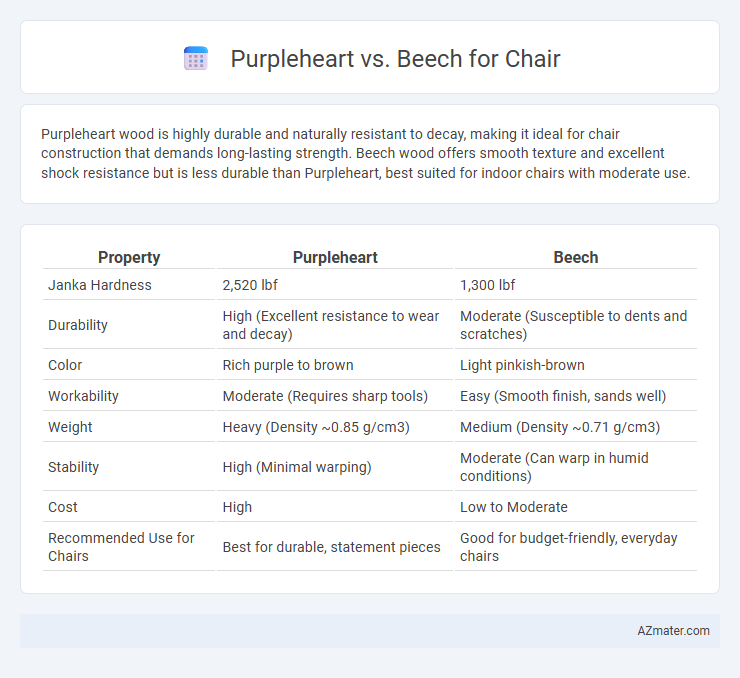Purpleheart wood is highly durable and naturally resistant to decay, making it ideal for chair construction that demands long-lasting strength. Beech wood offers smooth texture and excellent shock resistance but is less durable than Purpleheart, best suited for indoor chairs with moderate use.
Table of Comparison
| Property | Purpleheart | Beech |
|---|---|---|
| Janka Hardness | 2,520 lbf | 1,300 lbf |
| Durability | High (Excellent resistance to wear and decay) | Moderate (Susceptible to dents and scratches) |
| Color | Rich purple to brown | Light pinkish-brown |
| Workability | Moderate (Requires sharp tools) | Easy (Smooth finish, sands well) |
| Weight | Heavy (Density ~0.85 g/cm3) | Medium (Density ~0.71 g/cm3) |
| Stability | High (Minimal warping) | Moderate (Can warp in humid conditions) |
| Cost | High | Low to Moderate |
| Recommended Use for Chairs | Best for durable, statement pieces | Good for budget-friendly, everyday chairs |
Introduction to Purpleheart and Beech Wood
Purpleheart wood is known for its vibrant purple hue and exceptional durability, making it a striking choice for furniture such as chairs. Beech wood, characterized by a pale cream color with a fine, consistent grain, offers excellent strength and smoothness, ideal for comfortable seating. Both woods provide robust structural integrity, with Purpleheart excelling in hardness and Beech favored for its ease of finishing and resilience.
Physical Appearance and Color Differences
Purpleheart wood features a vibrant purplish hue that darkens to a rich brown with age, offering a unique and exotic look for chairs. Beech wood has a pale cream to light reddish-brown color with a fine, uniform grain, providing a classic and understated appearance. The striking purple shades of Purpleheart contrast sharply with Beech's more neutral and traditional tones, making each suitable for distinct aesthetic preferences in chair design.
Hardness and Durability Comparison
Purpleheart wood, with a Janka hardness rating of approximately 1,730 lbf, significantly surpasses Beech wood, which averages around 1,300 lbf, making Purpleheart notably harder and more resistant to dents and wear. The dense, close-grained structure of Purpleheart contributes to exceptional durability and resistance to scratches, ideal for long-lasting chair construction. Beech, while moderately hard and durable, is more prone to surface damage and shows wear faster under heavy use compared to the robust and enduring characteristics of Purpleheart.
Workability and Ease of Crafting Chairs
Purpleheart wood offers exceptional durability but can be challenging to work with due to its hardness and tendency to dull tools quickly, requiring sharp blades and frequent sharpening. Beech is favored for chair-making because of its excellent workability, smooth finish, and ease of shaping, making it ideal for intricate carvings and joinery. While Purpleheart provides superior strength and unique color, Beech delivers greater ease in crafting detailed and comfortable chair designs.
Weight and Density Considerations
Purpleheart wood has a density of approximately 850 kg/m3, making it significantly heavier and denser than Beech, which has a density around 720 kg/m3. The higher density of Purpleheart results in a sturdier, more durable chair but adds considerable weight, impacting portability and ease of movement. Beech offers a lighter alternative with sufficient strength for chair construction, balancing weight and durability for everyday use.
Cost and Availability in the Market
Purpleheart wood is considerably more expensive than Beech due to its rarity and exotic origin, often priced at two to three times higher per board foot. Beech is widely available in global markets, making it a cost-effective and accessible choice for chair manufacturing. The limited supply and higher demand for Purpleheart contribute to its premium cost and less frequent availability compared to Beech.
Environmental Impact and Sustainability
Purpleheart wood is highly durable and dense, sourced mainly from Central and South America, often harvested with sustainable forestry certifications to minimize environmental impact. Beech, commonly found in Europe and North America, grows quickly and is widely available, making it a more renewable choice with lower carbon footprint due to its fast growth and efficient regeneration. Both woods can be sustainable options if obtained from responsible suppliers, but Beech generally offers greater environmental benefits due to its rapid growth cycle and widespread availability.
Comfort and Ergonomics for Chair Use
Purpleheart wood, known for its density and natural durability, provides a solid and stable chair frame that enhances ergonomic support, aiding in maintaining proper posture during extended seating. Beech, with its slightly softer and more flexible properties, offers a degree of natural cushioning and resilience that can increase comfort by adapting subtly to body weight and movement. When comparing Purpleheart and Beech for chair use, Purpleheart's rigidity favors structural support while Beech's elasticity promotes dynamic comfort, making each suitable for different ergonomic priorities.
Maintenance and Longevity
Purpleheart wood is highly durable and resistant to decay, making it an excellent choice for long-lasting chair construction, with minimal maintenance required beyond regular dusting and occasional polishing. Beech wood, while also sturdy and resilient, is more susceptible to moisture damage and may need periodic refinishing and careful protection from humidity to maintain its appearance and structural integrity. Chairs made from Purpleheart typically offer superior longevity and lower upkeep costs compared to Beech, especially in environments with variable moisture levels.
Best Applications: Which Wood Suits Your Chair?
Purpleheart offers exceptional durability and rich purple hues ideal for statement chairs that require both aesthetic appeal and wear resistance. Beech wood features a fine grain and lighter color, making it perfect for chairs that prioritize comfort and traditional furniture styles with easy finishing options. For heavy-use seating, Purpleheart is best; for lighter, elegant designs, Beech is preferred.

Infographic: Purpleheart vs Beech for Chair
 azmater.com
azmater.com